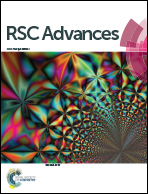Highly effective chemosensor of a luminescent silica@lanthanide complex@MOF heterostructured composite for metal ion sensing†
Abstract
Heterostructured chemosensors have excellent chemical stability, low contamination and excellent recyclability, and are regarded as a promising new generation of sensors with critical properties related to their sensing sensitivity and selectivity. Our preparation strategy for a heterostructured sensor is to construct it using a luminescent lanthanide complex and metal organic framework (MOF). A heterogeneous sensor is systematically produced using EuTTA and ZIF-8 to cover silica, and thin particles are obtained with small size and uniform morphology. Then, the particles were used as a highly selective and sensitive sensor to detect Cu2+ in aqueous solution. Eventually, we find that the well-structured silica@EuTTA@ZIF-8 microspheres have a good fluorescence stability, low detection limit and broad linear range in aqueous environments. These excellent properties make it a potential chemosensor for sensing of Cu2+ in environmental or biological solution systems.


 Please wait while we load your content...
Please wait while we load your content...